Sundance 2018 diary: ‘Come Sunday,’ ‘Leave No Trace’ and other closing highlights

Los Angeles Times film critics Kenneth Turan and Justin Chang talk about their favorite films at the 2018 Sundance Film Festival.
- Share via
Reporting from Park City, Utah — Times film critic Justin Chang is keeping a regular diary over the course of a week at the 2018 Sundance Film Festival. He will be writing about the movies he’s seeing, the trends he’s observing and what it all means for an event that officially kicks off the year in new independent cinema.
DAYS 7-10 | JAN. 24-27
Faith under fire in ‘Come Sunday,’ ‘Burden’ and ‘The Miseducation of Cameron Post’
I have long lamented the general dearth of smart, challenging, provocative reflections on faith and spirituality on our movie screens. For that very reason, I have also been eager to point out and celebrate those rare occasions when a filmmaker bucks the trend. And more often than not, it seems, those occasions arise at Sundance — a showcase for the best of American independent cinema, and thus an opportunity to see filmmakers explore one of the most significant and divisive aspects of American life.
I’m thinking of movies as different as “Higher Ground” (2011), Vera Farmiga’s gut-wrenching drama about a Christian woman’s slow-simmering crisis of faith, and “Last Days in the Desert” (2015), Rodrigo Garcia’s beautifully austere speculation on an early chapter from the life of Jesus. To this believer’s eyes, these are pictures that avoid the heavy-handed, proselytizing agenda of most “Christian cinema” and invite the full spectrum of human reactions: our contemplation, our skepticism and sometimes our awe.
That state of exaltation — the feeling that cinema can achieve, or at least approximate, a kind of transcendence — largely eluded me at this year’s Sundance. Still, there were moments that came powerfully close in “Come Sunday,” a new drama from the director and Sundance veteran Joshua Marston (“Maria Full of Grace,” “Complete Unknown”), starring a superb Chiwetel Ejiofor as the controversial Pentecostal preacher Carlton Pearson.
FULL COVERAGE: Sundance Film Festival 2018 »
Written by Marcus Hinchey and drawn from a 2005 “This American Life” piece called “Heretics,” the movie begins with Pearson in the peak of his career as a powerful preacher and beloved leader at Higher Dimensions, a mega-church in Tulsa, Okla. But shortly after he hears what he believes to be the voice of God, speaking to him in ways both direct and indirect, he begins preaching a gospel of universal salvation, effectively dismissing the idea of hell and contradicting years of strict evangelical doctrine. His congregation is shocked, incensed and split down the middle, testing Pearson’s devotion in ways he never imagined he’d have to face.
The movie distills this schism into a series of precisely written, beautifully acted conversations between Pearson and his church colleagues, in which we can sense years’ worth of Christian fellowship and emotional history suddenly being tested. Pearson’s most loyal friend and associate, Henry (a terrific Jason Segel), decides to leave to start a new church, while a senior leader (Martin Sheen) demands that he recant or else.
But it is Pearson’s wife, Gina (Condola Rashad), no fan of the church’s entrenched traditions, who urges him not suppress his inner convictions, regardless of what it may cost him. “Come Sunday” is too honest to spell out whether or not Pearson really is hearing the voice of God, which is what makes Marston’s drama so stirring. He knows that ambiguity and doubt, far from being the enemies of faith, are crucial to its sustenance.
A more straightforward ripped-from-the-headlines drama of Christian belief could be found in writer-director Andrew Heckler’s sturdily engrossing redemption drama, “Burden,” which won an audience award at the festival’s Saturday closing-night ceremony. The film tells the story of Mike Burden (a ferocious Garrett Hedlund), a South Carolina white supremacist who, through the love of a good woman (Andrea Riseborough) and the hospitality of a black preacher named Rev. Kennedy (Forest Whitaker), was able to throw off the yoke of the Ku Klux Klan.
With its blunt deer-in-the-woods symbolism and its borderline-caricaturish villains, chiefly a Klansman played with gleeful malevolence by Tom Wilkinson, “Burden” won’t win any prizes for subtlety. But it’s a tense, engrossing tale nonetheless, at once utterly sincere in its message that faith can move mountains — even violent, bigoted mountains — and reluctant to smooth over Burden’s rocky road to redemption. Heckler’s sense of modulation falters at times, but his skill with actors is undeniable.
Not every film I saw at Sundance was quite so faith-affirming: In “The Miseducation of Cameron Post,” religious belief is depicted less as a weapon of justice than as an instrument of emotional and psychological torture. A warm, polished and empathetic new feature from the writer-director Desiree Akhavan (“Appropriate Behavior”), the film stars Chloë Grace Moretz as the eponymous Cameron, a high schooler who gets caught making out with a girl and is promptly shipped off to God’s Promise, a Christian camp specializing in gay conversion therapy.
Adapted from Emily M. Danforth’s debut novel of the same title, the movie deftly plays Cameron’s experience for deadpan comedy and harrowing drama alike, both modes ably accommodated by Jennifer Ehle and John Gallagher Jr. as the camp’s misguided but not entirely unsympathetic leaders. What gives Akhavan’s movie its tonal elasticity is Moretz’s sweet, searching performance as a young woman still trying to figure herself out, and to fit in with a group of young people who already self-identify as misfits.
Instinctively, Cameron finds herself gravitating toward two fellow inmates (played by “American Honey’s” Sasha Lane and “The Revenant’s” Forrest Goodluck) who treat the whole experience with withering cool-kid sarcasm. Their engaging rapport makes “The Miseducation of Cameron Post” a pleasing anti-authoritarian comedy, though I wish it hadn’t felt the need to lunge for a violent (if conveniently tangential) tragedy to make its grimly obvious point. The dramatic tension might have been more acute, too, if Cameron’s struggle felt more like a struggle — if, like some of the other kids relegated to the sidelines here, she herself had a closer connection to the God ostensibly holding her identity hostage.
Debra Granik’s ‘Leave No Trace’ leaves a powerful impression
The U.S. dramatic jury, consisting of Octavia Spencer, Michael Stuhlbarg, Jada Pinkett Smith, Joe Swanberg and Rachel Morrison, clearly had no such reservations about “The Miseducation of Cameron Post,” as they awarded Akhavan’s film the grand jury prize on Saturday. Also among the group’s favorites were Ethan Hawke’s “Blaze,” which drew a well-deserved acting prize for its star, Benjamin Dickey; Reinaldo Marcus Green’s skillfully restrained police-shooting drama “Monsters and Men,” which won a first-feature prize; and Reed Morano’s polarizing science-fiction tale “I Think We’re Alone Now,” which drew an award for excellence in filmmaking.
I didn’t come close to seeing everything in the U.S. dramatic competition, but of those I did see, my own personal jury of one would have felt compelled to single out “Wildlife,” Paul Dano’s beautifully measured drama about the disintegration of a marriage, starring a terrific Carey Mulligan and Jake Gyllenhaal; and also “Tyrel,” Sebastián Silva’s unsettling ensemble comedy about a guy (the excellent Jason Mitchell) having an increasingly miserable time at a snowy weekend retreat. The movie’s racial dynamics — he’s black, they’re white — led many to bill it as “‘Get Out’ without the horror,” though if anything I found myself cringing more at “Tyrel.” At once a tense psychological study and an acute study in group dynamics, it affirms Silva’s skill at conjuring tension from both within and without.
Some of the finest films at Sundance this year, and indeed every year, screened in non-competitive categories and were thus ineligible for awards. Among the best of the lot was “Leave No Trace,” a triumphant return to narrative filmmaking for Debra Granik, whose much-acclaimed “Winter’s Bone” premiered exactly eight Sundances ago. Compared with that twisty Ozarks crime thriller, her new film is simplicity itself: an achingly observed portrait of a PTSD-stricken Army vet (Ben Foster, beautifully restrained) and his loving teenage daughter (Thomasin Harcourt McKenzie, in a star-making performance), who lead a nomadic existence together in a massive public park near Portland, Ore.
Their living situation is clearly untenable, though what happens feels almost secondary to the sheer wealth of atmosphere and texture the movie generates, almost entirely through formal means: Every shot, every cut, every closeup and every landscape has the effect of pulling us deeper into her narrative thicket. Granik is, if there were any doubt, a born filmmaker, and it’s marvelous to have her back.
DAYS 5-6 | JAN. 22-23
‘Colette’ and ‘Shirkers’ chronicle acts of artistic theft
Sundance Twitter lighted up not long after the recent world premiere of “Colette,” director Wash Westmoreland’s shrewd and spirited English-language comedy about the 19th-century French literary icon. The social-media excitement had little to do with the film’s largely positive reception, or with its eventual acquisition deal by Bleecker Street and 30West, administering a commercial shot in the arm to a festival that has seen relatively slow sales activity so far.
No, what galvanized festival-goers was the sight of the picture’s leading lady, Keira Knightley, dressed in a black tuxedo — a sly sartorial nod to her on-screen alter ego and the social barriers she broke in her time. For better or worse, no cinematic barriers are broken by “Colette” itself, which flies by smoothly, lands a few satisfying punchlines and works as a solid performance showcase for Knightley as Sidonie-Gabrielle Colette and Dominic West as her wildly irresponsible cad of a husband, Henry Gauthier-Villars, better known as Willy.
Set mostly in Belle Époque Paris, the movie — written by Rebecca Lenkiewicz, Westmoreland and his late husband, Richard Glatzer — quickly ushers us into this couple’s strange, mercurial marriage. It begins with something resembling genuine passion and eventually becomes a relationship of convenience, albeit more convenient for Willy than for Colette. Willy, a literary entrepreneur who can barely afford to pay his ghost writers, desperately urges Colette to try her hand at writing. She does and produces a novel, “Claudine at School,” which, after a few delays and some modest narrative embellishments from Willy, is published and becomes an instant sensation.
That Willy refuses to acknowledge Colette as the sole author of the unflaggingly popular “Claudine” series gives “Colette” something of a kinship with “Big Eyes,” Tim Burton’s 2014 film about the artist Margaret Keane, whose husband, Walter Keane, falsely claimed authorship of her paintings for years. Willy, well played by West, is a more endearing and complicated brand of con artist. He may be controlling, manipulative and chronically unfaithful, but he’s also liberated enough to let Colette have affairs of her own with women, as we see in a frothily amusing montage that briefly turns the story into a pansexual free-for-all.
Knightley, doing her strongest work in quite some time, shoulders the picture ably enough to suspend if not entirely banish one’s reservations about seeing (or rather, hearing) a French story rendered entirely in English. At the post-screening Q&A, Westmoreland shrewdly invoked the precedent set by Pascale Ferran’s marvelous “Lady Chatterley,” a French-language film that made no attempt to alter its British setting. But that film had a wild, unbridled sensuality that spoke far more directly and intuitively than human speech ever could. In “Colette,” by contrast, the lingual disjunction feels more like a concession to mainstream palatability.
Coincidentally enough, less than 24 hours after “Colette,” I walked into a much more adventurous story about a woman whose artistic output is stolen and suppressed by a ruthless male overseer. That’s a pretty reductive logline for Sandi Tan’s “Shirkers,” which is playing in the festival’s international documentary competition, but its mysteries are best left for the viewer to discover: This might be the most enjoyably singular new movie I’ve seen at this year’s Sundance so far.
“Shirkers” shares its title with a road movie that Tan set out to make 25 years ago with her friends when they were teenagers growing up in Singapore. Through a series of events too bizarre to spoil even if I were inclined to do so, the film was never finished. Much of the imagery we see consists of footage from the original production, and it’s an eccentric wonder to behold, as both a vivid time capsule of mid-’90s Singapore and a lovingly hand-crafted snapshot of Tan’s particular teenage obsessions.
Watching this footage, you can get a piercing sense of the mad, lysergic production that might have been. But what Tan has given us instead — an intensely personal guided tour of her upbringing, her pop-cultural scholarship, her cinematic obsessions, a whole life shaped by creativity and collaboration — feels no less rewarding.
‘Don’t Worry … ’ and ‘Blaze’ do their subjects justice
“Colette” wasn’t the only artist biopic to make landfall in Park City, Utah, this year. The festival’s early days brought us “Don’t Worry, He Won’t Get Far on Foot,” Gus Van Sant’s disarmingly sweet portrait of the late John Callahan, an alcoholic from Portland, Ore., who lost the use of his legs after a car accident at the age of 21; he eventually confronted his addiction head-on and discovered his calling as a cartoonist. (The movie’s title, which it shares with Callahan’s memoir, comes directly from one of his sly “Far Side”-style drawings, many of which we see here.)
Disability advocates have already condemned the casting of the able-bodied Joaquin Phoenix as Callahan, and while the ethics of representation haven’t received nearly the scrutiny they deserve, I can’t fault Phoenix’s performance. He’s terrific, subtly attuned to Callahan’s every emotional and physical transformation as he endures physical therapy, adjusts to life in a wheelchair and begins attending AA meetings, where his rage and bitterness — and also his humor, his melancholy and his affection for his fellow 12-steppers — come pouring out. The meetings are led by Donnie, who’s rich and gay and philosophical and has a killer wardrobe, and who’s wonderfully played by an almost unrecognizable Jonah Hill.
Van Sant, who also wrote the script, is working in a warm, amiable mode here that’s worlds away from either the formal austerity (“Paranoid Park,” “Gerry”) or the tearjerking awfulness (“The Sea of Trees”) that have defined his career arc of late. His chronology here is artfully scrambled, making frequent temporal leaps that always feel intuitive. It’s the right choice for a movie that shows progress to be rarely steady or linear, and that sees every life as the sum of its past, present and future.
A similarly fragmentary structure informs Ethan Hawke’s “Blaze,” a soulful, exquisitely textured portrait of the Arkansas-born, Texas-raised country-blues singer-songwriter Blaze Foley, played by Benjamin Dickey in the kind of deeply inhabited performance that goes far beyond the usual biopic mimicry. Most audiences won’t have a strong enough image of Foley to sufficiently judge the resemblance, but it hardly matters: Dickey, a guitarist himself, brings this boozy, irascible, dirty-joke-telling troubadour fully to life.
At the heart of the movie is a tender love story between Blaze and his wife, Sybil Rosen (Alia Shawkat), whose memoir served as the basis of the film. That thread bobs and weaves its way around two framing devices to which the movie keeps returning: a recording-studio interview with Foley’s legendary contemporary Townes Van Zandt (an excellent Charlie Sexton) and a re-enactment of Blaze’s fateful last night.
Musical storytelling clearly suits Hawke, who established his directing chops with “Seymour: An Introduction,” his superb 2015 documentary about the classical pianist Seymour Bernstein. The actor-turned-director has also clearly absorbed some lessons from his longtime collaborator Richard Linklater (who pops up in a few amusing scenes here, along with Sam Rockwell and Steve Zahn). “Blaze” has the ardor of Foley’s music and the winningly relaxed vibe of a great hangout movie. It’s messy, intimate and unruly, with a rhythm that sometimes meanders and trails off — much like one of Foley’s songs, and with the same sweetly lingering poetry.
DAYS 3-4 | JAN. 20-21
Jennifer Fox’s ‘The Tale’ is a brave, troubling portrait of sexual abuse
In “The Tale,” an early critical favorite at this year’s Sundance Film Festival and a drama of uncommonly troubling power, Laura Dern plays Jennifer Fox, a documentary filmmaker trying to remember an experience that befell her at the age of 13, when she was preyed upon sexually by an older man. The movie was written and directed by the real-life documentary filmmaker Jennifer Fox, who noted during the post-screening Q&A that, apart from the fact that she and Dern look nothing alike, the story is “pure memoir.”
“I’ve wanted to tell this tale since it happened to me when I was 13,” she said, and you can feel that urgency in every frame, even when the movie’s very foundations begin to shift beneath your feet like quicksand. With grueling intimacy, remarkable courage and a nervily intricate approach to psychology and narrative, Fox shuffles her painful memories like puzzle pieces and invites us to sift through them alongside her. She has made not only an unsparingly confrontational look at the trauma of abuse, but also an extended rumination on the unreliable nature of memory — the peculiar alchemy by which storytelling becomes a means of survival.
In this case, the title refers to a story that Fox wrote when she was 13 and spending a lot of time on weekends with her riding instructor, Mrs. G (played in the movie by Elizabeth Debicki), and her running coach, Bill (Jason Ritter). As we learn early on, Mrs. G and Bill are lovers, though their relationship is hardly exclusive. We see these two alluring adults, along with the young Jenny (Isabelle Nélisse, who was 11 at the time of shooting), in flashbacks that keep replaying themselves in slightly different configurations, visually mimicking the process by which the adult Jenny’s memory keeps shifting and correcting itself.
There’s a slippery kind of pleasure to be had in working out these narrative puzzles, and Fox, manipulating the details of her own story with ruthless cunning, knows how to draw us in even as the story itself becomes increasingly repellent. That push-pull tension is what gives “The Tale” much of its queasy power.
The slow-building horror of Bill’s predatory behavior is skillfully and responsibly handled (the closing credits are quick to inform us that every depiction of sexuality with a minor relied on an adult body double), but for many viewers — this one included — even Fox’s willingness to put us in the same room will be awfully hard to take.
Nothing about “The Tale” is pat, clear or easy. One measure of this is the fact that the adult Jenny, played by Dern in the latest of many terrific performances, keeps arguing with everyone around her: her angry, worried mother (Ellen Burstyn), her concerned fiancé (Common) and, most of all, her younger self. Certainly there will be plenty of time for audience members to debate the pleasures, frustrations and lacerating insights of “The Tale,” provided that it gets the gutsy theatrical distributor it needs.
My sense is that it will, if the standing ovation that Fox and her cast and crew received is any indication. There’s also the not-insignificant matter of the film’s relevance to our political and national mood. Not for nothing, I suspect, did Sundance programmers schedule the premiere of “The Tale” on Saturday, the same day that numerous women’s marches were being held across the country, including one here in Park City, Utah, uniting all protesters under the banner of #MeToo and #TimesUp, and kicking up another cloud of collective fury at the Trump administration.
To turn “The Tale” into a cinematic poster child for a much-needed feminist revolution would be reductive; Fox’s work is too thorny and specific an achievement to speak broadly for everyone. Which is not to say that the movement cannot be seized to this movie’s advantage, and vice versa. At the Q&A, a visibly stirred Burstyn decried “the exploitation of innocence” before going on to announce, “I want to thank Donald Trump for that disgusting tape that he made, that we all heard, that was the final straw that broke this camel’s back.”
‘American Animals,’ ‘Bisbee ’17’ blur the boundaries between truth and fiction
“The Tale” isn’t the only innovative melding of narrative and documentary forms in this year’s U.S. dramatic competition. The British director Bart Layton scored a hit at Sundance in 2012 with “The Imposter,” a portrait of a con artist that proved worthy of its slippery subject. He’s back this year with “American Animals,” a stylish and compelling account of a 2004 incident at Transylvania University in Lexington, Ky., in which four students plotted to steal a number of extremely valuable rare books from the school’s special collections library.
The students are played by Barry Keoghan, Evan Peters, Jared Abrahamson and Blake Jenner, and as dramatized here, the particulars of their harebrained scheme would be absorbing enough on their own terms. But the movie’s conceptually audacious twist is to intercut the narrative with interviews with the real-life conspirators: Spencer Reinhard, Warren Lipka, Eric Borsuk and Chas Allen, now all in their 30s and out of prison.
The men’s pointed reflections on how everything went down turn “American Animals” into an absorbingly multi-faceted portrait of how privilege, entitlement and boredom can give rise to wayward criminal impulses; imagine “I, Tonya” with less comic snarkiness and more dramatic integrity.
Whether we need more blow-by-blow procedurals about America’s dumbest amateur criminals is certainly open to debate, as is the net worth of Layton’s sly interweaving of fact and fiction. In his review for Indiewire, the critic David Ehrlich described “American Animals” as “the kind of thing that Robert Greene could make in his sleep if he wanted to go commercial” — an apt reference to the filmmaker behind such provocative, playfully self-reflexive documentaries as “Actress” and “Kate Plays Christine,” a 2015 Sundance favorite.
Fittingly enough, Greene is back in the U.S. documentary competition this year with a new movie called “Bisbee ’17,” and it shows no inclination toward selling out. With a purposefulness that reveals itself slowly yet surely, the movie delves into the troubled history of Bisbee, Ariz., a small border town whose rich copper deposits drew thousands of workers in the early 20th century, especially during World War I. A labor dispute led to the infamous Bisbee deportation of 1917, when 1,000 striking German and Mexican miners were shipped off at gunpoint and left for dead in the New Mexico desert.
Greene doesn’t just revisit this traumatic event; he reinhabits it, not only conducting interviews with the town’s present-day residents but also staging a dramatic re-creation of the deportation. It’s a completely rigged, artificial conceit that — as with so many of the completely rigged, artificial conceits in Greene’s work — turns out to be a surprisingly direct route to the truth.
In less assured hands, “Bisbee ’17” might have come across as an overly schematic thought experiment, rather than the coolly riveting, emotionally galvanizing achievement it is: a movie that doesn’t just put history on trial, but reminds us that we’re never not living it.
DAYS 1-2 | JAN. 18-19
Scenes from a marriage in Tamara Jenkins’ winning ‘Private Life’
The last time writer-director Tamara Jenkins had a new movie at the Sundance Film Festival was in 2007, the year she showed up with “The Savages,” her superb, ultimately Oscar-nominated tale of two siblings starring Philip Seymour Hoffman and Laura Linney. By that point, Jenkins’ fans were already accustomed to waiting: A full nine years had passed since her celebrated 1998 feature debut, “Slums of Beverly Hills.”
Even if the independent movie market were more receptive to sharply written, acutely observed relationship comedies, or more willing to finance projects by female filmmakers with a track record of acclaim and success, the 55-year-old Jenkins is clearly not someone to be rushed. She draws deep from the wellspring of personal experience and applies a careful but unfussy perfectionism to every detail.
And so it’s fitting that Jenkins’ new movie, “Private Life,” a Netflix production that kicked off Sundance’s Premieres section on a high note Thursday night, should be a movie in part about the agonies of waiting. Tender, blistering and exquisitely judged, it stars Paul Giamatti and Kathryn Hahn as Richard and Rachel Grimes, a middle-aged New York couple enduring an endless battery of fertility treatments in hopes of making their dream of childbirth a reality.
In the movie’s first shot (so to speak), we see Richard injecting Rachel in the posterior with a hormone that will stimulate her follicles in preparation for an IVF procedure — a literal pain-in-the-butt image that will become less funny and more quietly heartrending with each recurrence. The scene immediately establishes a casual intimacy with this hopeful, desperate, already exhausted couple, as does Jenkins’ meticulous attention to the texture of their rent-controlled East Village apartment, with its cramped rooms and shelves overflowing with books. (The Grimeses are both professional writers.)
If “Private Life” were merely an unusually observant portrait of a marriage or a terrific performance showcase, it would be enough. Giamatti, entirely in his element as the wearily dependable Richard, hasn’t had a role this meaty since “Win Win” (2011) and perhaps “Sideways” (2004). And Hahn more than matches him in vanity-free exhaustion; she makes palpable Rachel’s rage, despair and anxiety as she submits to one medical procedure after another, always finding the rueful laughter in her character’s situation without reducing her physical ordeal, or her wildly fluctuating hormone levels, to a punchline.
But the story’s empathy doesn’t end with Rachel and Richard; it flows beyond them, in gratifyingly unpredictable directions. We spend some time getting to know Richard’s stepbrother and his wife (John Carroll Lynch and Molly Shannon, both excellent), who have two young adult daughters of their own but offer a contrasting view of marital discontent. And the movie has a secret weapon in actress Kayli Carter (“Godless”), who gives a wonderfully open-hearted performance as the Grimeses’ 25-year-old niece, Sadie: Visiting them for a spell, she becomes the young daughter they never had and also something more.
Emerging from “Private Life” on Thursday, you could already hear the grumblings about its 132-minute running time, a common enough complaint at a festival that is constantly rushing us onward to the next screening and the next one, often to the detriment of the work in front of us. With any luck, the audiences who see the movie on Netflix will evince a bit more patience. What these criticisms miss is how artfully and meaningfully Jenkins pieces together her narrative from a hundred stray moments, exchanges, setbacks and indignities; she has made a movie about what it means to stay committed through the long haul.
Years in the making and all the better for it, “Private Life” itself is a reminder that good things take time — which doesn’t make me any less impatient for Jenkins’ next movie.
‘Blindspotting,’ ‘Monsters and Men’ put racial tension in the spotlight
In a festival that rarely wants for political currency, it’s surely no coincidence that “Blindspotting” and “Monsters and Men,” the first two films to screen in this year’s American dramatic competition, are both predicated on the same attention-grabbing plot point: the killing of a black man by a white police officer. It’s hardly the first time Sundance has held up a mirror to this particular recurring nightmare. One of its biggest hits in recent years was the 2013 drama “Fruitvale Station” (or “Fruitvale,” as it was known at the time), Ryan Coogler’s tense account of the 2009 killing of Oscar Grant III in Oakland.
Oakland figures even more prominently in “Blindspotting,” a funny, flashy, blood-spattered valentine to that Bay Area city, envisioned here as both a locus of fast-encroaching gentrification and a seething cauldron of racial anxiety. Collin (“Hamilton” sensation Daveed Diggs) has just three days of probation to go for committing a violent crime a year earlier, the nature of which will be strategically revealed at the midpoint. Until then, he’s eager to keep his head down, to no avail: On his way home one night, he witnesses a fellow black man being shot four times by a cop in the street, an image that haunts him even as he struggles to come forward with what he saw.
Making it even harder to stay out of trouble is Collin’s longtime pal Miles (Bay Area poet Rafael Casal), a white guy with a hair-trigger temper, a recklessly vicious streak and a fondness for handguns. In addition to being best friends and co-workers (they drive a moving van together), Collin and Miles are bound by their love of hip-hop — a passion that grows naturally out of Diggs and Casal’s own. (The two actors collaborated on the screenplay.) In its most creatively vibrant moments, “Blindspotting” verges on becoming a full-on slamming, rhyming musical, as if its insoluble riddles about class, crime and racial identity could only be worked out through poetry.
The downside of all this conceptual audacity is a weakness for overstatement, an inability to let its themes, its contradictions and even its fairly obvious title go unexplained. “Blindspotting” is an accomplished first feature for its director, Carlos López Estrada, but a first feature it very much remains: Bristling with energy and ambition, it’s the kind of movie that has an awful lot to say and not much trust in the audience’s ability or willingness to listen.
That places it in striking contrast with “Monsters and Men,” which covers some of the same ground to less attention-grabbing but quietly superior effect. Directed with impressive restraint and assurance by the first-time filmmaker Reinaldo Marcus Green, the movie tells a triptych of stories unfolding in present-day Brooklyn, each set in motion by another fatal police shooting of an unarmed black man.
One of the witnesses to the tragedy is a young man named Manny (Anthony Ramos), who captures the killing on video and, increasingly disturbed by the footage, posts it online. Peaceful protests follow, but so does a wave of anti-police violence, and Manny himself will pay a price for his act of conscience. In short order, he will pass the narrative baton to Dennis (John David Washington), a black cop who finds himself experiencing the worst of both worlds: Relentlessly profiled by white cops when he’s off-duty, he’s also criticized by family members for not doing more to help protect his fellow brothers on the street.
What can any of us do? That query, with its stealth call to activism, is very much at the heart of “Monsters and Men,” which places three men of color at a moral crossroads. The third and youngest of these is Zyrick (Kelvin Harrison Jr.), a smart, thoughtful high school athlete who plans to attend college on a baseball scholarship. We don’t know that when we first meet him, however; he’s just another black kid in a hoodie, getting frisked by the cops on his way home one evening.
Green plays out each of these stories to slow, steadily absorbing effect, avoiding every impulse toward either phony contrivance or pat resolution. Patrick Scola’s cinematography is flowing, alert and remarkably expressive. At times, he resorts to the neorealist technique of keeping the camera glued to the backs of his characters’ heads, as though trying to penetrate their thoughts. The thrilling, sharply abbreviated final shot doesn’t capture everything that’s going on for Zyrick, which is just as well: One of the lessons of this tough-minded and boldly unresolved movie is that thoughts matter, but actions matter more.
2018 Sundance Film Festival


Video: Adapting 'Hamlet' for a woman's point of view in 'Ophelia'

Video: 2018 Sundance Film Festival Boomerangs

Video: A behind-the-scenes look at the 2018 Sundance L.A. Times photo/video studio

Video: The Kronos Quartet premieres its live documentary

"The Kindergarten Teacher" shows something many movies don't

Video: Filmmakers share thoughts on the future of women in film, the U.S. and storytelling
More to Read
Only good movies
Get the Indie Focus newsletter, Mark Olsen's weekly guide to the world of cinema.
You may occasionally receive promotional content from the Los Angeles Times.











